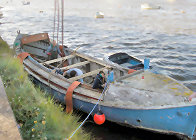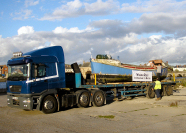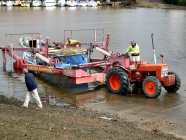
The Early Stages
The Beginning
After the initial telephone calls a lifeboat enthusiast was able to get down to Barnstaple where the former lifeboat lay, neglected on a grass bank. The boat was found in quite a poor state, complete with a substantial amount of debris that had built up over the years. There was no doubt that the boat was without question an old lifeboat, although at that point it was yet to be positively identified. Despite the poor visible condition the hull seemed to be in a fair condition. It was clear from the start that any restoration project was going to be quite an undertaking.

Once the purchase was secured the enthusiast and his partner began the gruesome task of clearing away many years of dirt and grime, it was by no means an easy task and at times it must have seemed overwhelming, although that was only the beginning. After some propriety cleaning, paint was scraped away from the stem post as it was likely that some identification marks could be found here. The markings "TL 37 " were found and it was these marks that finally identified the former lifeboat as the "William Riley of Birmingham & Leamington".

The use of a motor engine fitted during one of the lifeboat conversions had added a substantial amount of waste oil and lubricants to the lifeboat bilge, all of which had to be manually removed and safely disposed of.
The Recovery

On the 12th August 2005, a meeting was held to discuss the task of getting the lifeboat from Barnstaple in Devon, back to Whitby. Friday the 19th August coincided with a large tide and it was decided that this was the best opportunity to retrieve the lifeboat.
A team of willing volunteers team set off to recover the lifeboat from a grass bank on the River Taw where it would only float on really high tides. The river had been the berthing point for the former lifeboat for many years, so much so that a few weeks before the recovery exercise the lifeboat had to partially cleaned out in readiness. Removing some of the rubbish however, revealed some concerning holes in the bottom of the hull. Temporary patches were made in order to make the lifeboat essentially semi watertight and it was then only a matter of waiting for the rising tide. As the river rose the boat slowly began to float, proof that the temporary patches were holding. It was then necessary to make good time in getting the boat away from the grass bank, no easy easy task as navigating the route was difficult because of a scattering of boats moored precariously along the chosen route.
In order to get the lifeboat to a suitable lifting point, the team were forced to wade around the obstacles and along the grass bank, staying within the safety of the grass bank, this in itself was no mean feat when pulling the lifeboat along at the same time.

The lifeboat was pulled alongside a small quayside where it was secured ready for lifting. Strops were carefully placed under the hull and positioned close to planking that had been placed width ways to prevent the hull from collapsing inwards. The recovery team was mindful of getting the hull lifted as soon as possible whilst the temporary patches were holding. With the lifeboat carefully lifted out of the water it was placed onto a trailer for its journey back to Whitby. The trailer and transport arrangements were graciously provided by Geoffrey Robinson of Dawson and Robinson (Transport) Ltd, Skinningrove. Only when the boat was safely secured on the trailer could the recovery team breathe a sigh of relief.
The Return
Having been saved from certain destruction down in Devon, the former lifeboat finally made it back to Whitby on the 20th August.

News of the William Riley arriving back in Whitby quickly spread and shortly thereafter a crowd of interested onlookers had gathered to witness the homecoming. Paul Wilson, a local videographer was on hand to record the arrival and in doing so he interviewed members of the recovery team. Paul covers most local events making his own unique brand of DVD's. He has a plethora of titles to his credit and has plans to produce a comprehensive lifeboat DVD further down the line. Paul was the main cameraman during a recreation of a famous lifeboat pull re-enactment in 1999, He gave his time freely as it was for a most worthy cause and the DVD has since made a considerable sum for the RNLI, it is featured prominently in the local lifeboat museum. His aim was to compile footage as the restoration progressed so as to make a new title from the footage which will also help raise funds for the RNLI.

With the unit back in Whitby all that was left to do was to remove it from the trailer, thankfully Coates Marine were only too happy to help using their travel lift. It was not a straight forward task as the height of the trailer was such that it was too high for the travel lift to lift it off and lower it to the ground in one lift. In order to get the lifeboat to a lower point it was taken off the trailer first then taken to the nearby slipway and carefully lowered into the water.
The lifeboat showed no problems as it was allowed to gently settle in the water the temporary patches holding any water ingress back as the slings were adjusted. The lifeboat was then lifted from the water and transferred to the marina car park where it was kept as a two week temporary holding point.
Copyright © Colin Brittain 1999 - 2022